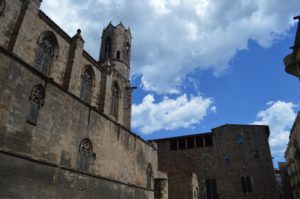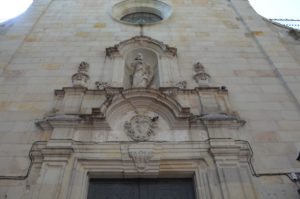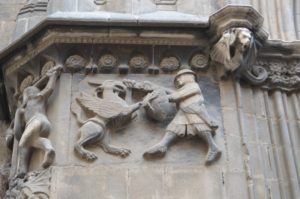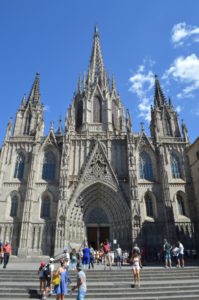
June 26, 2017
From the window of Conesa (my favorite local sandwich shop) with my pork, veggie, and cheese sandwich in hand, I look out onto St. James’ Plaza where the Taxi drivers of Barcelona protest the competition imposed by Uber. As they hoist their signs and shout along to Queen’s “We Are The Champions”, I can’t help but imagine if political manifestations of the old Roman Forum bore any resemblance to these moderns demonstrations. This central plaza in Barcelona’s Gothic Quarter served as the Forum in the old Roman city, Barcino, and is just one of many recuerdos of the rich history of Barcelona and Catalonia that connects this modern globalized city to the times of Christ.
 In the labyrinth, stone-paved streets of El Barrio Gotico, you can find medieval romanesque churches tucked into the twists and folds of the alleyways, a dark, dusty, quiet escape from the roar of Las Ramblas. You can find the legend of Sant Jordi engraved into the intricate gargoyles adorning the royal palaces. You can find San
In the labyrinth, stone-paved streets of El Barrio Gotico, you can find medieval romanesque churches tucked into the twists and folds of the alleyways, a dark, dusty, quiet escape from the roar of Las Ramblas. You can find the legend of Sant Jordi engraved into the intricate gargoyles adorning the royal palaces. You can find San  Nicolas, the small hidden church in which Antoni Gaudi prayed every day. You can find an archive housing letters from Christopher Columbus to Queen Isabell and King Ferdinand as he undertook his journey to the New World. You can find the lesser known Fredric Mares Museum, home to over 3,000 works of sculpture from all periods in human history.
Nicolas, the small hidden church in which Antoni Gaudi prayed every day. You can find an archive housing letters from Christopher Columbus to Queen Isabell and King Ferdinand as he undertook his journey to the New World. You can find the lesser known Fredric Mares Museum, home to over 3,000 works of sculpture from all periods in human history.
 Although named El Barrio Gotico, this region at the center of Barcelona is not limited to the history and art of a fleeting medieval architectural period. El Barrio Gotico has been the heart of Barcelona since its founding as a Roman port to its expansion into an international city of more than 7 million. Every age, every historic event, every artistic movement, every inhabitant of Barcelona, every tourist has left subtle marks on this aged neighborhood, in the carving of buildings, in the worn cobblestones roads, in the prayers sent from the local churches. El Barrio Gotico contains the hearts and fantasies of all that encounter it.
Although named El Barrio Gotico, this region at the center of Barcelona is not limited to the history and art of a fleeting medieval architectural period. El Barrio Gotico has been the heart of Barcelona since its founding as a Roman port to its expansion into an international city of more than 7 million. Every age, every historic event, every artistic movement, every inhabitant of Barcelona, every tourist has left subtle marks on this aged neighborhood, in the carving of buildings, in the worn cobblestones roads, in the prayers sent from the local churches. El Barrio Gotico contains the hearts and fantasies of all that encounter it.